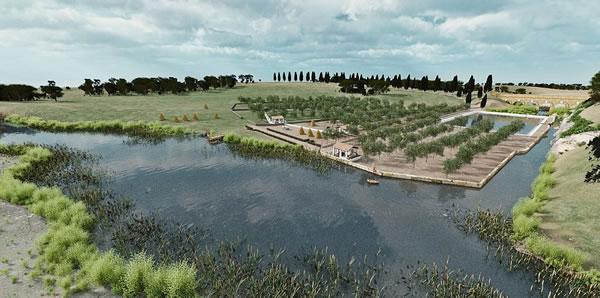Discovered a farm in the suburb of Ancient Rome

A 34 x 69 meter long water collection tank emerged from the excavation mud near Porta San Giovanni in Rome. It was the year 2012 and the discoveries continued during the drilling for the Rome subway new line C, in fact from the cistern started some tufa canalization to irrigate an orchard because the structure was pertinent to a rustic villa where peaches were grown.
The waters that were collected from the cistern were those of the stream known as Aqua Craba that came from the Marciana Valley on the border of the tenimenta of civitas tuscolana, where there were also the springs that then fed the aqueducts of Aqua Tepula and Aqua Julia.
A branch of the river was regimented and bent towards Rome, its course was underground, perhaps because, as told Frontino was "damnatam" because "gross"so much that Agrippa did not want to enter it in the aqueduct that was building as curator aquae. However, if it was "Aqua damnata" for the uses of men, it was instead perfect as irrigation water and so once returned to the surface just before Rome, already from the third century BC was feeding the irrigation system of a farm that then it specialized in the production of peaches.
The cultivation of peaches, of which roots of the trees and fruit pits have been found, shows that the fruit was brought to Rome in the II century BC after the conquest of Greece, where Alexander the Great had brought it after having seen in the gardens of Darius.
The company has estimated that it has a size of 14,000 square meters, at least according to what has been investigated, although it may be reasonable to assume that building a pool of about 2,400 square meters was exaggerated to irrigate just 12,000 square meters of orchard and this without taking into account the basin that was before the cistern that was powered by an incoming rivus and then had to have another one that running along the valley Murcia then went to throw itself into the Tiber.
The findings indicate that the farm was founded as early as the 3rd century BC and remained active until the first century AD.
As the area changed from the first century to the end of the empire, only other discoveries can be said, while it is certain that after the invasion of Totila during the Gothic wars, the area returned to being countryside and partly uncultivated if still Etienne Duperac, in the map of 1574, draws the torrent of the Aqua Crabra that runs in the fields beyond the walls.
Archaeological excavations for the Sant John's Station, carried out in several times between 2010 and 2013, have allowed us to explore an exceptional succession, over 20 meters deeper, of archaeological deposits on a total surface of almost 3,000 square meters.
Next April 2018, as announced by the Capitoline administration, those who come to Rome will be able to see with their own eyes not only the rediscovered structures of the orchard but trace through the exhibits all the historical events of the area and, through explanatory graphics, the transformation of the landscape over the centuries to the deepest geological levels dating back to the Pleistocene.
by M.L. ©ALL RIGHTS RESERVED (Ed 1.0 - 07/02/2018)







Related Articles: